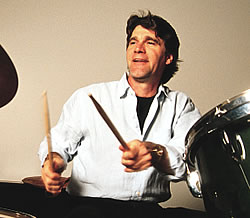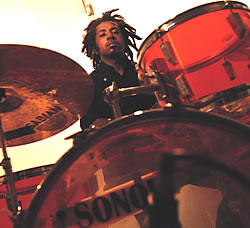 |
|
|
|
|
|
|
|
|
|
||||||||

|
|
|||||||||||||||||||||
The Beat Goes On |
John Bryant and Earl Harvin attended North Texas in different decades, but both say they spent their waking moments consuming music. They picked things up from friends, absorbed all they could in the classroom and played every gig available to become better drummers. And while both have found success complementing other musicians professionally, they've used what they learned at North Texas and beyond to become their own kind of percussionists. Each has created his own avenue of music, marching to his own beat. The left foot Bryant says his biggest musical influence was Ray Charles' left foot. As "Ray's Drummer," Bryant knew that keeping time with the pace of that dress shoe meant the difference between a good night and musician hell. In fact, he would tell you that doing things "Ray's Way" was the only way to keep his job.
"Working for someone in music is about serving a master," Bryant says. "It was, ‘What does Ray Charles want?' not, ‘Let me see what I can do with this music.' It served a purpose. It honed my skills." Bryant came to UNT inspired by his high school band teacher and the One O'Clock Lab Band of 1967. He wanted to be like Ed Soph ('68), the One O'Clock drummer who today teaches on the UNT percussion faculty. "Coming to UNT was like being in a brotherhood of musicians," Bryant says. "My experience at UNT was this giant musical experiment where we took chances and tried so many new things. It was unparalleled." He says one of his biggest influences at North Texas was fellow student Barry Ries. "He played trumpet, but he was also a fine drummer and he taught me things that just weren't in the curriculum," Bryant says. Ries currently works as a trumpet player in New York. "Barry got me listening to Miles Davis and John Coltrane and understanding the inner workings of small bands and infusing that into our big band performances. It was a big ‘a-ha' moment in my life." Unbelievable opportunities Bryant left North Texas in the fall of '74 before completing his degree to tour with the Paul Winter Consort, an internationally known world music group. This was a proud accomplishment for Bryant, but not everyone was thrilled with his success -- especially not his folks back in Virginia. "It was an unhappy task telling my parents that I was leaving school," Bryant says. "But it was an unbelievable opportunity." When he returned from touring the world, he received another once-in-a-lifetime opportunity, this time from Charles. "I was off with Ray for the next two years," says Bryant. "I recorded two albums with him, did two tours and even went on the The Tonight Show with Johnny Carson." Charles was a tough taskmaster, Bryant says, and he didn't mind putting someone on the spot if he didn't like what he heard. "He was from a different generation of musician," Bryant says. "It was always about competition and Ray wasn't afraid to call anybody out." Bryant says it wasn't always great doing things "Ray's Way," but he took from it a tenacity to create "John's Way." Today he fulfills his need to innovate through his percussion group, D'Drum. He and his associates collect drums from India, Bali and across Africa and bring them back to master, perform on and teach others to play. A different drummer The drumming of Harvin, who attended North Texas from 1985 to 1987, has been featured in many genres -- from the rock of The The to the funk of Billy Goat, the punk of the Psychedelic Furs and the ballads of Seal. He's also worked with Air, who did the soundtracks for Lost in Translation and The Virgin Suicides.
The main thing Harvin took from those experiences was the desire to create his own art. "The reality of working for somebody else is that you're helping them realize their music. You can't call it your own," he says. "You're part of it and important to it or else you wouldn't be there, but in the end I can't, for instance, claim Seal's record as my own." Harvin's music is an innovative jazz that combines elements of all his experiences in other music genres. His group, the Earl Harvin Trio, uses everything from punk to pop and even hip-hop to perform and create its unique brand of progressive jazz. The group was actually formed as an escape from what Harvin would tell you are the worst gigs in the world for musicians -- weddings. They rate as his own special level of musical purgatory, topped only by playing the same standards in a country bar. "My best day, I remember giving a friend my tux and saying, ‘I'm never playing another one of these awful gigs again,'"
he says. "They don't pay worth anything and it was just playing the same version of the standards a million times on some really heinous gigs." The Gone House The Earl Harvin Trio started out as a pool of 10 people, each performing when time allowed breaks from their more lucrative, but less creative, music jobs. In fact, the reason the group bears Harvin's moniker is that he was the only consistent member. He invited anybody to play and experiment. "The chance to bring your own music -- that only happens in school," Harvin says. Harvin was living in the Gone House -- one of the humblest shacks in Denton -- which you could rent (with all bills paid) for $75 in 1987, he recalls. It was called the Gone House because the Gone Men, a group with some musical success at the time, lived and practiced there. The place was also a high-traffic way station for struggling musicians in town. Harvin left UNT in 1988 but stayed in Denton another two years and joined the band Ten Hands, which enjoyed some success in Texas. The Gone House was also where he met many of the musicians coming into the trio. One day the trio just clicked, Harvin says, as he was playing with UNT professor of music Fred Hamilton on the bass and guitar and Dave Palmer ('92) on the keyboard. "We were on a gig and looked around and realized this was pretty cool," Harvin says. "It wasn't planned. It just came down to me, Fred and Dave playing together." One of the most noted creations from the group was the 1999 album The Earl Harvin Trio at the Gypsy Tea Room, a live performance filled with hours of musical improvisation and a far cry from the jazz standards. Influencing genres Today Harvin lives in Los Angeles, experiencing more lucrative work with a host of other musicians. However, performing in the trio remains a kind of home. Bryant, in addition to his work with D'Drum, maintains a production studio in Dallas for his company, Bryant Hames Music. Through it he writes musical scores for documentaries and commercials. Both musicians say you've got to pay the bills, but it's important to continually strive to be an influence on your music genres and other up-and-coming musicians. "That's the way it should be," Bryant says. "I emphasize to other musicians that everybody's got their own way."
|
||||||||||||||||||||

